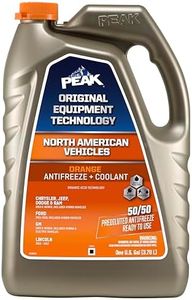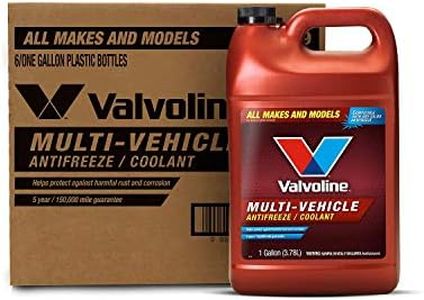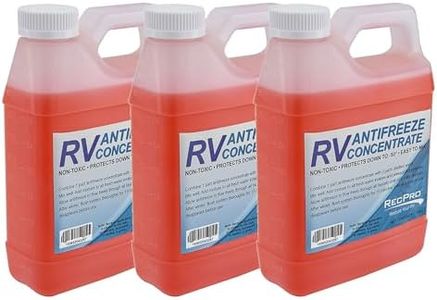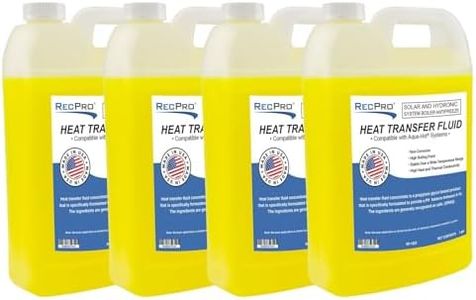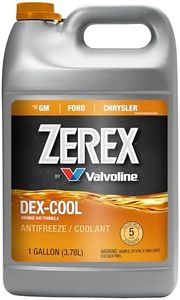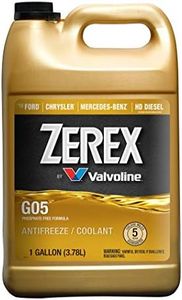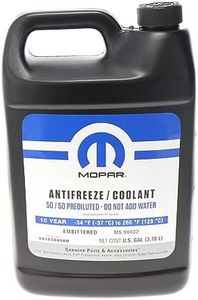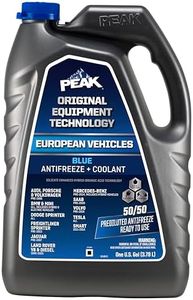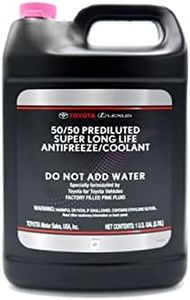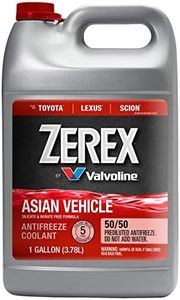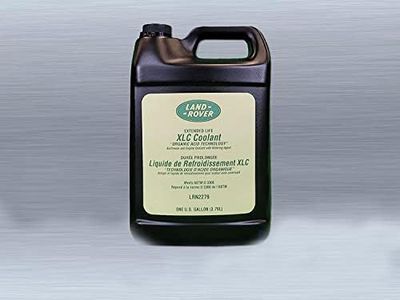10 Best Antifreeze Coolants 2025 in the United States
Our technology thoroughly searches through the online shopping world, reviewing hundreds of sites. We then process and analyze this information, updating in real-time to bring you the latest top-rated products. This way, you always get the best and most current options available.

Our Top Picks
Winner
PEAK OET Extended Life Orange 50/50 Prediluted Antifreeze/Coolant for North American Vehicles, 1 Gal.
Most important from
2238 reviews
The PEAK OET Extended Life Orange Antifreeze/Coolant is a ready-to-use 50/50 prediluted formula designed primarily for North American vehicles, especially those from Ford, Chrysler, and GM that require an orange organic acid technology coolant. Because it's prediluted, it makes topping off your cooling system quick and easy without needing to mix water. This antifreeze is formulated to protect your engine from rust and corrosion, helping maintain the health of all cooling system parts. It also includes a bittering agent, Denatonium Benzoate, which adds safety by discouraging accidental ingestion.
Compatibility is a strong point since it works well with other extended life antifreezes, making it flexible if you’re topping off an existing system. One of its standout features is the long service life it offers—when used after a complete system flush, it can protect your engine for up to 400,000 miles or 15 years, which is excellent for those looking for durable protection.
This product is tailored mainly for specific North American brands requiring the orange OAT formula, so it might not be the best fit for vehicles needing different antifreeze types, like traditional green or yellow coolants. Also, because it’s prediluted, you’re paying for the convenience of ready-to-use fluid, which could be a bit more expensive compared to concentrated versions that you mix yourself. This antifreeze is a solid choice for owners of compatible vehicles who want long-lasting protection and easy maintenance without the hassle of mixing, but it’s important to check your car’s coolant requirements before buying.
Most important from
2238 reviews
PEAK OET Extended Life Red/Pink Concentrate Antifreeze/Coolant for Asian Vehicles, 1 Gal.
Most important from
2010 reviews
The PEAK OET Extended Life Red/Pink Concentrate Antifreeze/Coolant is designed specifically for Asian vehicles, making it a great choice for owners of Lexus, Scion, and Toyota cars. One of its major strengths is its type, Phosphate-Enhanced Organic Acid Technology (POAT), which is tailored to the cooling systems of these brands. This product is a concentrated formula, which means it can be diluted to the desired concentration, making it versatile for flushing, filling, or topping off the cooling system.
Compatibility is another strong point, as it is fully compatible with other extended life antifreeze/coolants, ensuring you won’t have issues mixing it with existing fluids in your vehicle. The advanced formulation with additives like Denatonium Benzoate helps in preventing rust and corrosion, providing protection to all engine cooling system components. Additionally, PEAK offers a guarantee that, when used correctly, this coolant will provide service life protection for up to 150,000 miles or 5 years. This gives users peace of mind regarding the longevity and effectiveness of the product.
Being a concentrate, users need to properly mix it with water, which can be an added step for those who prefer ready-to-use solutions. Also, it’s specifically recommended for Asian vehicles, so it may not be ideal for those with different car brands. Despite these minor drawbacks, the PEAK OET Extended Life Red/Pink Concentrate Antifreeze/Coolant stands out as a reliable and efficient choice for maintaining the cooling systems of compatible Asian vehicles.
Most important from
2010 reviews
PEAK OET Extended Life Pink Concentrate Antifreeze/Coolant for European Vehicles, 1 Gal.
Most important from
901 reviews
The PEAK OET Extended Life Pink Concentrate Antifreeze/Coolant is specifically designed for European cars like Audi, Fiat, and Saab that require a silicate-free Organic Acid Technology (OAT) formula. This makes it a good choice if you have a compatible vehicle, as it prevents rust and corrosion effectively, protecting all parts of your cooling system. Being a concentrate, it allows you to mix it to the right strength, which is practical for flushing and topping off your coolant.
The product promises a long service life of up to 150,000 miles or 5 years when used as part of a full system flush and fill, which is quite good and means fewer fluid changes. It also includes a bittering agent to discourage accidental ingestion, adding a safety feature. On the downside, this antifreeze is tailored mainly for European vehicles requiring a pink OAT formula, so it might not be suitable for all car makes or older vehicles needing different antifreeze types like traditional green or yellow formulas.
Since it’s a concentrate, it requires proper mixing, so you need to be careful with dilution to avoid any cooling system issues. If you drive a European vehicle with recommended pink OAT coolant, this product provides strong protection, long-lasting service, and good value, but it’s not a one-size-fits-all solution for every car.
Most important from
901 reviews
Buying Guide for the Best Antifreeze Coolants
Choosing the right antifreeze coolant for your vehicle is crucial for maintaining its engine health and performance. Antifreeze coolants help regulate the engine's temperature, preventing it from overheating in the summer and freezing in the winter. When selecting an antifreeze coolant, it's important to consider several key specifications to ensure compatibility with your vehicle and optimal performance. Here are the key specs you should focus on and how to navigate them.FAQ
Most Popular Categories Right Now
